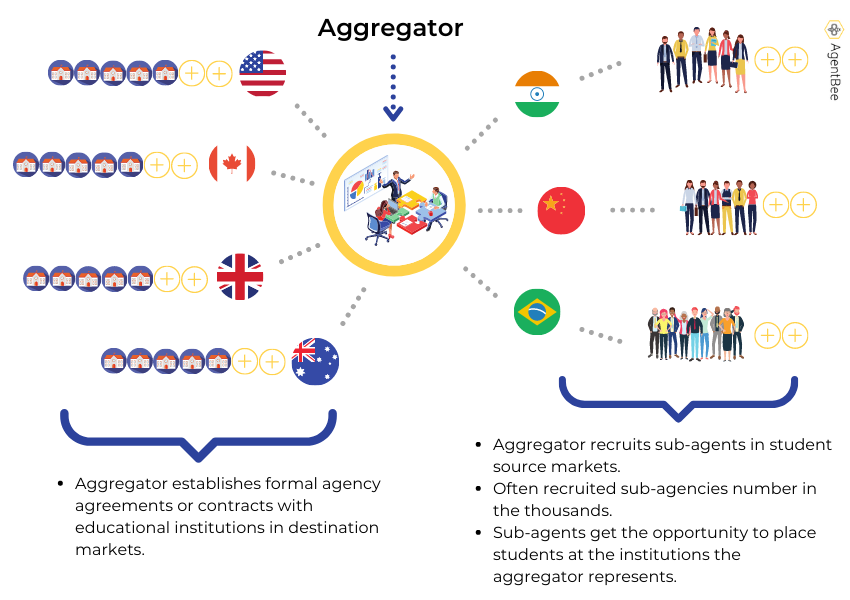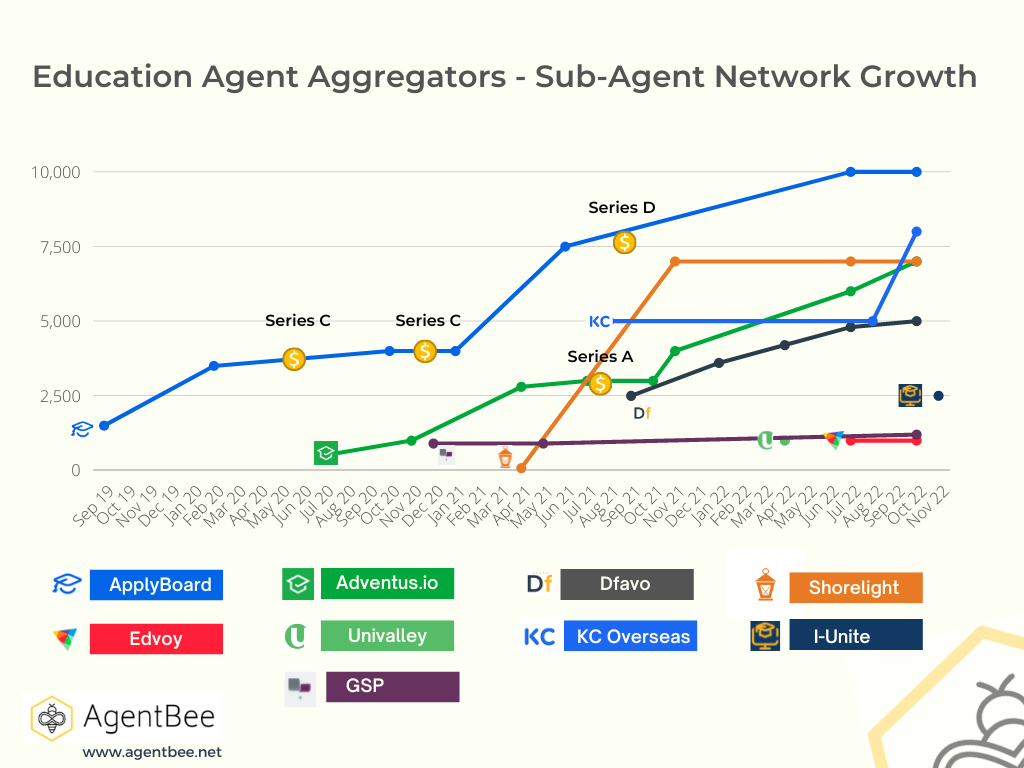(First published June 2021. Last update – December 2022.)
Much has been written recently about the rise and market impact of education agent aggregators. An education agent aggregator acts a market hub, bringing together large numbers of educational institutions and education agents with the aim of recruiting large numbers of international students.

The education agent aggregator business model is a numbers game. Success depends on:
- establishing agency agreements or contracts with a large number of high quality educational institutions – it is this client list that is the major draw card for potential sub-agents
- recruiting an army of sub-agents and supporting them with technology solutions to generate international student applications.
If one of these elements is missing the business model does not work, at least at scale:
- not enough institution clients and sub-agents will opt to work with an aggregator who has more, and
- not enough sub-agents means insufficient student application volume to keep client institutions happy, and to generate revenue.
Sub-agent armies
So how is all of this playing out on the ground? In short the big education agent aggregators are recruiting huge armies of sub-agents. Let’s take a look at some of the key players.
The above is not an exhaustive list of education agent aggregators. There are many other businesses of different shapes and sizes running education agent aggregator models, or variations on the theme. Each of them is busy recruiting their own sub-agent army.
Cause for concern?
The market seems to have spoken and the aggregators are clearly doing a lot right and serving their customers well to be growing so quickly.
But some have concerns.
In June 2021, UKEAS conducted a survey of UK university partners gauging sentiment around the agent aggregator business model. They received over 100 responses, of which approximately 1/3rd were Heads of International, or Directors and above.
On the issue of sub-agents, here are some of the views expressed:
They say they control the subagents but do they really? I doubt it, we all know how it really works, but I might be too skeptical, only time will tell, South Asia the real test and compliance and Visa success rates in 21/22 and beyond.
Lack of student relationship, lack of subagent control/standards, accepting agents that an institution would never work with directly, conflicting activity.
University reputation and working ethics of sub-agents.
Lack of clarity over whom the sub agents are.
In December 2022, ICEF produced an excellent podcast, bringing together an expert panel to discuss issues around education agent aggregators. Panel member Eddie West, Assistant Dean, International Strategy and Programs, San Diego State University, expressed reservations:

I feel like the arrival and emergence of aggregators has massively set back the cause of transparency, because now all of a sudden if you are working with an aggregator you yourself as an institution often don’t know who those thousands of sub-agents are who are representing you. That’s not good.
There’s almost no way to ensure thorough integrity of training and quality oversight with the aggregator model.
A lot, if not all, of these sub-agent networks are anonymous. They are just behind the cloak of the aggregator and, as someone commented online recently, anonymity and accountability rarely go hand in hand.
5 questions to ask an education agent aggregator to manage sub-agent risk
If you are working with education agent aggregators, or plan to, you should ask some simple questions.
1. How many sub-agents do you have in your network, and who are they?
In a story about the UKEAS survey, The PIE news spoke with a higher education professional who said that one area of concern related to institutions not being clear about who the aggregators were working with.
Some of the aggregators said absolutely, we can share the list of who we work with if that’s something that you want to see. Others were less keen to share that information with us. What they were all reasonably open on was if we had particular partners that we didn’t want to work with, or perhaps partners that we had previously worked with … that would be taken on board. But the fact that a number were not comfortable sharing the list of who they work with, set some alarm bells for us as well.
If you agree to work with an aggregator, they will incorporate your brand and courses in their technology platform and promote it to their sub-agent army. In turn, those sub-agents will engage directly with students on your institution and what it has to offer. You’re entitled to know who those sub-agents are.
2. What due diligence do you do on sub-agents before agreeing to work with them?
An important part of the aggregator pitch to new educational institution clients is that they vet new sub-agent partners. It is important to understand exactly what that means.
What quantitative and qualitative data sources does the aggregator use? What percentage of potential new sub-agents do they decline, and on what basis?
3. What is your process for on-going due diligence on sub-agents?
Checking and assessing a sub-agent before agreeing to work with them is critical, but equally important is that the education agent aggregator has in place a strong process for ongoing sub-agent due diligence.
What ongoing checks does the aggregator conduct on sub-agents? What is the process? How often are ongoing checks conducted, and what information is considered?
4. What standards do you apply to your sub-agents?
This relates to questions 2 and 3 above. It is important to understand the decision making and policy framework that underpins an aggregator’s sub-agent vetting process.
What are the factors that determine whether the aggregator will, or will not, work with a new sub-agent? What standards does the aggregator set, and how are those standards enforced? What is the threshold or trigger that would cause an aggregator to terminate its relationship with a sub-agent?
A useful benchmark here is the regulatory approach adopted in Australia, New Zealand and Manitoba. The legislative wording varies between those jurisdictions, but in broad strokes, educational institutions:
- must conduct checks and satisfy themselves that an education agent will behave honestly and with integrity before agreeing to work with them, and
- terminate the relationship with an agent if they know or have reason to believe that the agent has noted acted honestly or with integrity, or has engaged in conduct that is misleading or deceptive.
You should require agent aggregators to apply the same standards in relation to their sub-agents.
5. How many sub-agents have you terminated your relationship with in the last 12 months, and for what reason?
If an aggregator has a sub-agent army numbering in the thousands it is reasonable to expect that each month, quarter or year, a number of those sub-agents will fall short of the standards set out above. When that happens the aggregator should terminate its relationship with the sub-agent.
Any aggregator should be able to tell you how many sub-agents it has ended its relationship with and why.
Worried about education agent and sub-agent risk?
AgentBee’s education agent due diligence solution enables in-house international student recruitment teams to manage education agent risk by:
- running checks on new education agents before entering into an agreement with them
- conducting regular ongoing due diligence checks on the agents they are working with
- surveying student about their experience with their education agent, and
- receiving a notification each time we add a new report on an education agent to our database.


